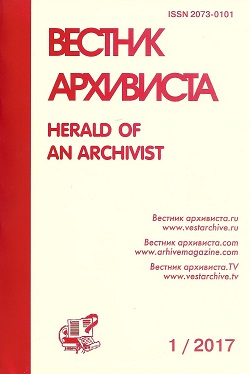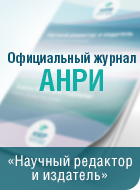Scientific article
doi 10.28995/2073-0101-2024-1-166-178
For citation
Madzharov, Alexander S. «The Tale of the Massacre of Mamayev»: religious symbols in structure of historical description. (In Russ). IN: Vestnik Archivista / Herald of an Archivist, 2024, no. 1, pp. 166-178. doi 10.28995/2073-0101-2024-1-166-178
Madzharov, Alexander S., Baikal State University, Irkutsk, Russian Federation
«The Tale of the Massacre of Mamayev»: religious symbols in structure of historical description
Abstract
Sources on the history of the Battle of Kulikovo have been studied in detail in Russian historiography. Much attention in the literature was paid to “The Tale of the Massacre of Mamaev.” Soviet-era scientists made significant contributions to his research. However, in the works of the 50-80s. XX century, dedicated to this work, the worldview of the medieval author was sometimes interpreted in a modern political science key. Turning to the analysis of the content of the historical source, the authors identified “religious and moralizing maxims” in its structure, which were qualified as a “form of political thought”, a manifestation of a political tendency. It was argued that the text expressed the “interests of the working masses” and served the cause of progress. D.S. Likhachev wrote about the need to study the worldview embodied in the source. A.M. Panchenko emphasized the influence of the “everyday” (worldview) layer, as the foundation that determined behavioral structures, moral prohibitions, on the event layer. The influence of the “everyday” layer on the “event” layer was also reflected in “The Tale of the Massacre of Mamayev,” but this relationship was not studied. Let us consider, based on the Cyprian edition of the work, comparing it with other editions, religious epistemes that reveal the medieval understanding of the meaning of the battle, as the ideal motive of the participants in the Battle of Kulikovo, which influenced its outcome. The author of the Cyprian edition of the “Tale” narrated the battle in the context of the worldview and literary etiquette of his time: faith, sacred actions, moral assessments, ideas about what should be. According to his views, the preparation and course of the Battle of Kulikovo took place within the framework of the providential area and internally motivated human actions. The creator of the “Tale” emphasized the religious “mechanism” of preparation for battle and combined the spiritual mood of the warriors with real military operations. He connected the events of the current day with the facts of sacred history, interpreted them in the spirit of sacred reality, perceived and described the victory in the battle as a “miracle” that happened in an atmosphere of religious faith. The idea of the importance of faith as a value for which the battle was fought was carried out in all editions of the monument. This was evidenced by Dmitry Ivanovich’s calls to the soldiers. This idea was professed by Metropolitan Cyprian. Religious symbols in the text of the “Tale” revealed the subjective logic of man, the meaning of personal moral responsibility on the path to victory. In life and in work, they performed the role of psychological and methodological attitudes appropriate to the time.
Keywords
The Legend of the Massacre of Mamayev, Cyprian's edition, historical source, literary etiquette, religious worldview, values, subjective logic, interpretation.
Download the article: madzharov_doi
References
Dmitriev, L. A. The Kulikovo Battle in Old Russian literary monuments (In Russ.). IN: The Tale of the Kulikovo Battle. Text and miniatures of the 16th century facial vault. Leningrad: Aurora, 1984. 392 p.
Dmitriev, L. A. Publicistic Ideas of "The Tale of the Battle of Mama" (In Russ.). IN: Proceedings of the Department of Old Russian Literature. VOL. XI. Moscow; Leningrad: Academy of Sciences of the USSR, 1955, pp. 140-155.
Dmitriev, L. A. Literary history of the monuments of the Kulikovo cycle (In Russ.). IN: Tales and stories about the Kulikovo battle. Leningrad: Nauka, 1982. pp. 306-359.
Likhachev, D. S. Poetics of Old Russian Literature. Moscow: Nauka, 1979. 360 p.
Panchenko, A. M. On Russian History and Culture. St. Petersburg: Azbuka, 2000. 464 p.
Kloss, B. M. Nikonovsky vault and Russian annals of the XVI-XVII centuries. Moscow: Nauka, 1980. 312 p.
Salmina, M. A. Once again about the dating of the "Chronicle Tale" about the Kulikovo Battle (In Russ.). IN: Kulikovo Battle. Proceedings of the Department of Old Russian Literature. Textology and Poetics of Russian Literature of the XI-XVII Centuries. Т. 32. Moscow: Nauka, 1977. 395 p.
Tales and tales about the Kulikovo Battle. Moscow: Nauka, 1982. 434 p.
About the authors
Madzharov Alexander Stanislavovich, doctor of history, professor, the Baikal state University, department of Philosophy and Art History, professor, Irkutsk, Russian Federation, +7-914-941-68-74, This e-mail address is being protected from spambots. You need JavaScript enabled to view it
The article was received in the editorial office on 16.10.2023, recommended for publication on 20.12.2023.














